#scrape restaurant data
Text
Scrape Restaurant and Menu Data | Grubhub | SkiptheDishes | Menulog
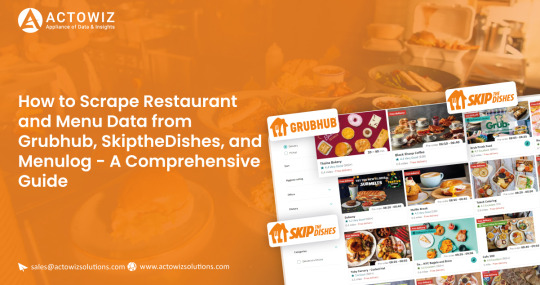
Introduction
The culinary landscape has witnessed a marked transition towards online avenues in the digital era. Platforms like Grubhub, SkiptheDishes, and Menulog have emerged as leading luminaries in this sector, extending a diverse array of dining establishments and culinary choices to consumers for enterprises and analysts keen on tapping into this extensive data reservoir; employing a restaurant menu scraper becomes indispensable. This blog elucidates the nuances of extracting restaurant and menu details from these platforms.
Furthermore, businesses can access curated datasets tailored to their needs with specialized services such as the menu and restaurant data collection services from Grubhub. Additionally, Grubhub food delivery data scraping services offer insights into consumer preferences, delivery patterns, and market trends. Leveraging these food delivery data scraping services and data collection methodologies, stakeholders can derive actionable insights, optimize operations, and stay abreast of evolving market dynamics.
Understanding the Landscape

Before diving into the intricate process of web scraping, it's imperative to acquaint oneself with the distinct characteristics of the targeted platforms:
Grubhub: Recognized as a frontrunner in the online and mobile food-ordering and delivery sector, Grubhub boasts a vast network of restaurants and a user-friendly interface. Those seeking comprehensive insights may benefit from utilizing a restaurant menu scraper tailored for Grubhub or opting for specialized services like the menu data collection service from Grubhub or the restaurant data collection service from Grubhub. These offerings facilitate seamless extraction and analysis of pertinent data, providing a holistic view of the platform's operations.
SkiptheDishes: Catering predominantly to the Canadian audience, SkiptheDishes serves as a pivotal link between diners and local eateries. Its unique data architecture and user experience present opportunities and challenges for data extraction endeavors.
Menulog: With a robust presence in the Australian and New Zealand markets, Menulog offers diverse food ordering options. Navigating its platform necessitates understanding its data intricacies to ensure adequate Grubhub food delivery data scraping services or comparable food delivery data scraping services.
While these platforms present invaluable data reservoirs, successful data collection hinges on adeptly navigating their distinct interfaces, structures, and potential hurdles.
Preparation and Preliminary Steps
Legal compliance remains paramount when venturing into web scraping, especially concerning platforms like Grubhub. Always adhere strictly to the platform's terms of service and pertinent data protection statutes. Unauthorized Grubhub food delivery data scraping services or restaurant data collection services from Grubhub can culminate in severe legal ramifications.
Before initiating data extraction, delineate the precise data elements of interest: restaurant names, menu items, pricing structures, customer reviews, or ratings. This meticulous approach streamlines the data collection process and enhances the efficacy of your restaurant menu scraper or food delivery data scraping services.
Equally pivotal is the selection of appropriate tools to facilitate data extraction endeavors. Opt for established frameworks such as Scrapy, Beautiful Soup, or Selenium, renowned for their versatility in navigating intricate web structures. These tools are adept at handling dynamic content, managing cookies, and ensuring a seamless Grubhub food delivery data collection or related food delivery data collection tasks.
Meticulous planning, adherence to legal stipulations, and leveraging adept tools are quintessential for successful and compliant data-scraping endeavors in food delivery.
Scraping Methodologies
Grubhub:
URL Structuring: Grubhub exhibits a discernible pattern in its URLs, facilitating a streamlined navigation process across diverse restaurant and menu pages. This structural consistency augments the efficiency of a restaurant menu scraper.
Pagination: A distinct feature of Grubhub is the aggregation of multiple restaurants on individual pages, accompanied by pagination functionalities. Leveraging adept scraping tools, one can systematically traverse these pages, ensuring exhaustive restaurant data collection.
Dynamic Content: Grubhub's dynamic content loading necessitates tools such as Selenium. These tools bolster the Grubhub food delivery data scraping services by emulating user interactions, ensuring every data facet remains explored.
SkiptheDishes:
Geographic Specificity: SkiptheDishes mandates location-sensitive scraping methodologies to serve a multifaceted regional clientele. This geographic adaptability ensures a holistic menu data collection service from Grubhub and similar platforms.
Data Formatting: SkiptheDishes' data may manifest in diverse formats. Employing rigorous data cleansing and normalization techniques, fostering consistency across the extracted datasets, is imperative.
Rate Limiting: Given potential rate-limiting strategies, vigilance is paramount while scraping SkiptheDishes. Employing strategic delays or integrating proxy services attenuates associated risks, preserving the integrity of food delivery data collection processes.
Menulog:
Region-Specific Data: As a stalwart in the Australian and New Zealand markets, Menulog necessitates region-centric scraping strategies. Adhering to these nuances ensures an informed and precise restaurant data collection service from Grubhub and its peers.
Structured Data: Menulog often presents its data in a structured, standardized framework, simplifying scraping endeavors. Nonetheless, the evolving platform landscape mandates periodic script refinements to synchronize with any structural alterations.
Data Validation: Ensuring data congruence with Menulog's official listings post-scraping safeguards against discrepancies. A proactive approach to updating scraping methodologies underpins sustained data accuracy and relevance.
In conclusion, an astute amalgamation of platform-specific insights, robust scraping tools, and diligent validation protocols fortifies the efficacy of restaurant and food delivery data scraping endeavors across Grubhub, SkiptheDishes, and Menulog.
Challenges and Considerations in Data Scraping
Data Consistency: One of the foremost challenges in web scraping pertains to the transient nature of online data. Platforms like Grubhub frequently refresh menus, adjust pricing, and introduce new offerings. For stakeholders relying on accurate insights, this necessitates recurrent scraping cycles. Additionally, rigorous data validation protocols become indispensable and integral to a comprehensive restaurant menu scraper or a menu data collection service from Grubhub. These measures collectively ensure the availability of timely, relevant, and precise datasets, reinforcing the integrity of food delivery data scraping services.
Ethical Considerations: Ethical integrity remains at the crux of sustainable web scraping endeavors. Adhering to established protocols, such as respecting robots.txt directives, stands paramount. Overburdening servers with relentless requests can compromise platform performance and breach ethical boundaries. Moreover, conscientiously aligning data utilization practices with platform stipulations safeguards against potential legal ramifications and fosters a harmonious digital ecosystem.
Data Storage: The proliferation of data, a byproduct of extensive scraping endeavors, necessitates adept storage infrastructures. Cloud-based solutions emerge as a viable recourse, given their scalability and accessibility attributes. AWS S3 and Google Cloud Storage offer robust, secure, and scalable storage frameworks tailored for voluminous datasets. Concurrently, relational databases like PostgreSQL present structured storage solutions, augmenting data organization and accessibility.
While the allure of expansive datasets and actionable insights remains compelling, stakeholders must navigate the multifaceted challenges inherent to web scraping. A judicious fusion of technical understanding, ethical discernment, and strategic resource allocation underpins successful and sustainable restaurant and food delivery data collection endeavors across platforms like Grubhub.
How Actowiz Solutions Can Help in Scrape Restaurant and Menu Data from Grubhub, SkiptheDishes, and Menulog?
Navigating the intricacies of web scraping, particularly from prominent platforms like Grubhub, SkiptheDishes, and Menulog, demands expertise, precision, and a nuanced understanding of platform dynamics. This is precisely where Actowiz Solutions emerges as your strategic ally.
Tailored Solutions: Actowiz Solutions offers specialized tools and frameworks adeptly designed to scrape Grubhub food delivery data and analogous datasets from SkiptheDishes and Menulog. Our state-of-the-art restaurant menu scraper is meticulously calibrated to capture intricate menu details, pricing structures, and customer reviews, ensuring a holistic Grubhub food delivery data collection.
Comprehensive Offerings: Beyond mere scraping, Actowiz extends an encompassing menu data collection service from Grubhub, furnishing stakeholders with curated datasets characterized by accuracy, timeliness, and relevance. This holistic approach ensures clients are equipped with actionable insights, empowering informed decision-making and strategic planning.
Ethical Compliance: Upholding ethical standards remains paramount at Actowiz Solutions. Our methodologies strictly adhere to platform guidelines, encompassing respect for robots.txt directives and judicious data utilization practices. This ethical underpinning safeguards clients from potential legal pitfalls and fosters a collaborative digital ecosystem.
Scalable Infrastructure: Recognizing the voluminous nature of data in web scraping endeavors, Actowiz Solutions champions scalable storage solutions. Leveraging cloud-based platforms like AWS S3 and Google Cloud Storage, we ensure seamless data accessibility, integrity, and security, augmenting the efficiency of food delivery data scraping services.
Expert Support: Beyond technical prowess, Actowiz Solutions prides itself on a team of seasoned professionals adept at navigating platform nuances. Our experts offer continuous support, ensuring clients harness the full potential of scraped data, driving innovation and fostering growth.
In essence, Actowiz Solutions stands poised to revolutionize your data journey, delivering unparalleled restaurant and food delivery data scraping services tailored to your unique requirements across Grubhub, SkiptheDishes, and Menulog.
Conclusion
Harnessing the vast reservoirs of restaurant and menu data from platforms such as Grubhub, SkiptheDishes, and Menulog can be transformative for businesses and researchers. These insights pave the way for informed decisions, strategic planning, and unparalleled market understanding. Yet, the journey of web scraping demands meticulous attention to legal nuances, ethical practices, and unwavering commitment to data accuracy.
At Actowiz Solutions, we understand the intricacies of this process. Our cutting-edge restaurant menu scraper and dedicated menu data collection service from Grubhub are designed to cater to your precise data needs. Whether you seek Grubhub food delivery data scraping services or comprehensive data collection across platforms, we're your trusted partner.
Master the digital realm with Actowiz. Dive deep into insights, fuel innovation, and stay ahead of the curve. Elevate your data-driven strategies with our expertise. Reach out today and unlock the power of data like never before! You can also reach us for all your mobile app scraping, instant data scraper and web scraping service requirements.
#Scrape Restaurant Data#Scrape Grubhub Data#Skipthedishes Scraping#Scrape Menulog Data#Menu Data Scraping
0 notes
Text
How to Do Restaurant Data Collection Using Food Intelligence?
At Actowiz Solutions, were your window into the bustling US and UK restaurant industry. Dive into Actowiz Solutions Blog and Harness the Power of Real-Time Data.d practical meal-serving apps.
0 notes
Text
Tapping into Fresh Insights: Kroger Grocery Data Scraping
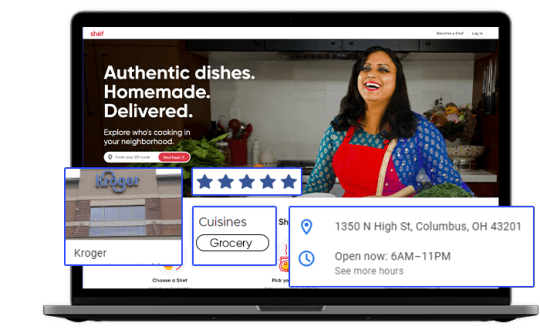
In today's data-driven world, the retail grocery industry is no exception when it comes to leveraging data for strategic decision-making. Kroger, one of the largest supermarket chains in the United States, offers a wealth of valuable data related to grocery products, pricing, customer preferences, and more. Extracting and harnessing this data through Kroger grocery data scraping can provide businesses and individuals with a competitive edge and valuable insights. This article explores the significance of grocery data extraction from Kroger, its benefits, and the methodologies involved.
The Power of Kroger Grocery Data
Kroger's extensive presence in the grocery market, both online and in physical stores, positions it as a significant source of data in the industry. This data is invaluable for a variety of stakeholders:
Kroger: The company can gain insights into customer buying patterns, product popularity, inventory management, and pricing strategies. This information empowers Kroger to optimize its product offerings and enhance the shopping experience.
Grocery Brands: Food manufacturers and brands can use Kroger's data to track product performance, assess market trends, and make informed decisions about product development and marketing strategies.
Consumers: Shoppers can benefit from Kroger's data by accessing information on product availability, pricing, and customer reviews, aiding in making informed purchasing decisions.
Benefits of Grocery Data Extraction from Kroger
Market Understanding: Extracted grocery data provides a deep understanding of the grocery retail market. Businesses can identify trends, competition, and areas for growth or diversification.
Product Optimization: Kroger and other retailers can optimize their product offerings by analyzing customer preferences, demand patterns, and pricing strategies. This data helps enhance inventory management and product selection.
Pricing Strategies: Monitoring pricing data from Kroger allows businesses to adjust their pricing strategies in response to market dynamics and competitor moves.
Inventory Management: Kroger grocery data extraction aids in managing inventory effectively, reducing waste, and improving supply chain operations.
Methodologies for Grocery Data Extraction from Kroger
To extract grocery data from Kroger, individuals and businesses can follow these methodologies:
Authorization: Ensure compliance with Kroger's terms of service and legal regulations. Authorization may be required for data extraction activities, and respecting privacy and copyright laws is essential.
Data Sources: Identify the specific data sources you wish to extract. Kroger's data encompasses product listings, pricing, customer reviews, and more.
Web Scraping Tools: Utilize web scraping tools, libraries, or custom scripts to extract data from Kroger's website. Common tools include Python libraries like BeautifulSoup and Scrapy.
Data Cleansing: Cleanse and structure the scraped data to make it usable for analysis. This may involve removing HTML tags, formatting data, and handling missing or inconsistent information.
Data Storage: Determine where and how to store the scraped data. Options include databases, spreadsheets, or cloud-based storage.
Data Analysis: Leverage data analysis tools and techniques to derive actionable insights from the scraped data. Visualization tools can help present findings effectively.
Ethical and Legal Compliance: Scrutinize ethical and legal considerations, including data privacy and copyright. Engage in responsible data extraction that aligns with ethical standards and regulations.
Scraping Frequency: Exercise caution regarding the frequency of scraping activities to prevent overloading Kroger's servers or causing disruptions.
Conclusion
Kroger grocery data scraping opens the door to fresh insights for businesses, brands, and consumers in the grocery retail industry. By harnessing Kroger's data, retailers can optimize their product offerings and pricing strategies, while consumers can make more informed shopping decisions. However, it is crucial to prioritize ethical and legal considerations, including compliance with Kroger's terms of service and data privacy regulations. In the dynamic landscape of grocery retail, data is the key to unlocking opportunities and staying competitive. Grocery data extraction from Kroger promises to deliver fresh perspectives and strategic advantages in this ever-evolving industry.
#grocerydatascraping#restaurant data scraping#food data scraping services#food data scraping#fooddatascrapingservices#zomato api#web scraping services#grocerydatascrapingapi#restaurantdataextraction
3 notes
·
View notes
Text
How Restaurant Analytics is Used to Boost Business Revenue?
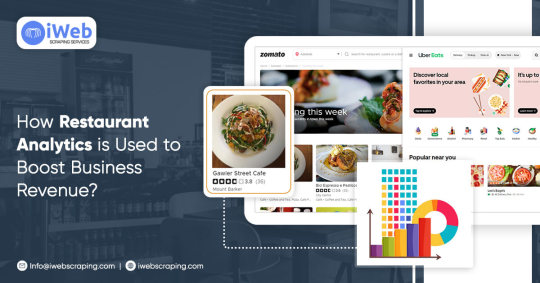
In today's dynamic and competitive restaurant industry, staying ahead of the curve is crucial for success. Beyond offering delectable dishes and impeccable service, savvy restaurant owners are turning to restaurant analytics to gain insights into their operations and make informed decisions. From menu optimization to personalized marketing strategies, leveraging data analytics has become a game-changer in maximizing revenue and enhancing the overall dining experience. Let's delve into how restaurant analytics is revolutionizing the industry and driving business growth.
1. Menu Optimization:
One of the primary ways restaurant analytics boosts revenue is through menu optimization. By analyzing sales data, customer preferences, and profitability metrics, restaurant owners can identify top-selling items, as well as underperforming dishes. This insight allows them to streamline their menu offerings, highlighting popular items while phasing out those that don't resonate with customers.
Moreover, analytics can reveal valuable information about pricing strategies. By evaluating the relationship between price points and sales volume, restaurants can adjust their menu prices strategically to maximize profits without alienating customers. For instance, data might indicate that certain dishes are priced too low given their popularity, presenting an opportunity for margin improvement.
2. Enhanced Customer Experience:
Understanding customer behavior is essential for delivering a personalized dining experience. Restaurant analytics enables owners to capture and analyze data from various touchpoints, including online reservations, mobile apps, and loyalty programs. By tracking customer preferences, dining habits, and feedback, restaurants can tailor their offerings to meet individual preferences and enhance customer satisfaction.
For example, if analytics reveal that a significant portion of customers prefer vegetarian options, the restaurant can expand its vegetarian menu or promote existing vegetarian dishes more effectively. Similarly, personalized promotions and targeted marketing campaigns based on customer data can drive repeat business and increase customer loyalty.
3. Operational Efficiency:
Efficient operations are key to maximizing revenue and minimizing costs in the restaurant industry. Restaurant analytics provides valuable insights into operational performance, allowing owners to identify bottlenecks, optimize staffing levels, and streamline processes.
For instance, by analyzing sales patterns and foot traffic data, restaurants can adjust staffing schedules to match demand, ensuring that they have the right number of employees during peak hours while avoiding overstaffing during slow periods. This not only improves customer service but also helps control labor costs.
Furthermore, analytics can optimize inventory management by predicting demand and identifying trends. By monitoring ingredient usage and supplier performance, restaurants can minimize waste, reduce inventory holding costs, and ensure that popular menu items are always available.
4. Strategic Decision-Making:
In today's competitive landscape, data-driven decision-making is paramount for long-term success. Restaurant analytics provides owners with valuable insights into market trends, competitor performance, and consumer preferences, empowering them to make informed strategic decisions.
For example, by analyzing customer demographics and dining trends in their area, restaurants can identify opportunities for expansion or diversification. Similarly, benchmarking against competitors and industry standards can help restaurants set realistic goals and benchmarks for growth.
Moreover, analytics can inform marketing strategies, enabling restaurants to allocate resources effectively and maximize ROI. Whether it's launching targeted digital advertising campaigns or partnering with influencers, data-driven marketing initiatives can significantly impact revenue generation.
Conclusion:
In conclusion, restaurant analytics has emerged as a powerful tool for boosting business revenue and driving growth in the competitive restaurant industry. By leveraging data to optimize menus, enhance the customer experience, improve operational efficiency, and make strategic decisions, restaurants can gain a competitive edge and thrive in today's market.
As technology continues to evolve, the role of analytics in the restaurant industry will only become more pronounced. Embracing data-driven insights will not only help restaurants adapt to changing consumer preferences but also unlock new opportunities for innovation and success. Ultimately, the adoption of restaurant analytics is not just about maximizing revenue; it's about delivering exceptional dining experiences that keep customers coming back for more.
0 notes
Text

Lensnure Solution provides top-notch Food delivery and Restaurant data scraping services to avail benefits of extracted food data from various Restaurant listings and Food delivery platforms such as Zomato, Uber Eats, Deliveroo, Postmates, Swiggy, delivery.com, Grubhub, Seamless, DoorDash, and much more. We help you extract valuable and large amounts of food data from your target websites using our cutting-edge data scraping techniques.
Our Food delivery data scraping services deliver real-time and dynamic data including Menu items, restaurant names, Pricing, Delivery times, Contact information, Discounts, Offers, and Locations in required file formats like CSV, JSON, XLSX, etc.
Read More: Food Delivery Data Scraping
#data extraction#lensnure solutions#web scraping#web scraping services#food data scraping#food delivery data scraping#extract food ordering data#Extract Restaurant Listings Data
1 note
·
View note
Text
#loki#loki season 2#tom hiddleston#health#Healthy Restaurant#healthy living#healthy lifestyle#healthy eating#healthy food#healthy diet#healthylifestyle#restaurant point of sale#restaurant pos system#restaurant management software#restaurant data scraping#restaurant design
0 notes
Text
How to Use Zomato API to Scrape Restaurant Data – A Detailed Guide

Introduction
In the dynamic world of digital gastronomy, where culinary delights and dining experiences are increasingly explored and celebrated online, the demand for up-to-date restaurant data is insatiable. As food enthusiasts and businesses seek the latest insights into menus, reviews, and more, the Zomato API emerges as a powerful tool for scraping this invaluable information.
Our comprehensive guide delves into the intricate art of utilizing the Zomato API to scrape restaurant data. Whether you're a restaurateur striving to understand your competitors, a food blogger searching for fresh content, or a data enthusiast eager to explore culinary trends, this guide will serve as your compass in the world of data extraction.
We will navigate through the intricacies of Zomato Scraper, uncovering its capabilities to provide you with rich, real-time restaurant data. From scraping restaurant details to accessing customer reviews, our detailed guide ensures that you harness the full potential of this resource.
Prepare to embark on a data-driven culinary journey, where you'll unlock a wealth of insights, enabling you to make informed decisions, craft engaging content, and explore the ever-evolving realm of restaurant experiences. Welcome to a world where the digital table is set, and the Zomato API is your key to an exquisite menu of data-driven possibilities.
Zomato: Transforming the Restaurant Business
In the bustling realm of the restaurant business, where culinary arts meet customer preferences, Zomato has emerged as a transformative force. With its roots in India, Zomato has rapidly evolved into a global restaurant discovery and food delivery platform, redefining how we explore, experience, and engage with dining establishments.
Zomato's journey began as a humble restaurant review website, helping diners discover new places to eat, explore menus, and share their dining experiences. Over time, it expanded its horizons to offer a comprehensive ecosystem for diners and restaurateurs.
Zomato is a one-stop destination for diners to explore an extensive database of restaurants, read authentic reviews, view ratings, and even reserve tables. Its user-friendly interface and intuitive features make finding the perfect dining spot for any occasion more accessible.
However, Zomato's impact transcends the diner's experience alone. It has revolutionized the restaurant business by empowering restaurateurs with valuable insights and tools. Through its services, restaurants can establish a digital presence, organize their online reputation, and reach a broader audience. Zomato has become a trusted partner for restaurant owners looking to boost their visibility and attract new customers.
One of Zomato's standout features is its data-driven approach. It collects vast data on restaurant menus, pricing, user reviews, and more. This data is a goldmine for restaurateurs, helping them make informed decisions about their offerings and pricing strategies. It also facilitates data-driven marketing and personalized customer engagement.
Moreover, Zomato's foray into food delivery services has further revolutionized the industry. With the convenience of ordering food from your favorite restaurant and delivering it to your doorstep, Zomato has disrupted the traditional dining experience. Its efficient delivery network has made it a go-to platform for foodies craving restaurant-quality meals from the comfort of their homes.
In a fast-changing and very competitive industry, Zomato continues to innovate, adapting to the evolving needs and preferences of diners and restaurant owners. It has not only transformed the way we discover and enjoy food but has also empowered restaurants to thrive in the digital age. As Zomato continues to expand its global footprint, it remains a dynamic and influential player in the restaurant business, shaping the future of dining experiences.
What Data Can You Get from Zomato?
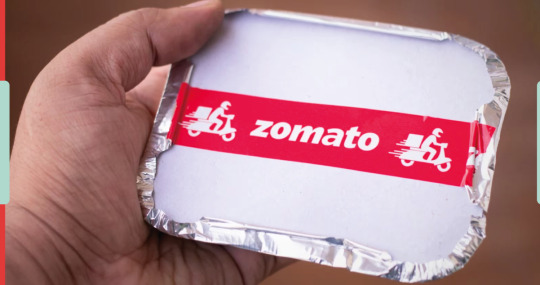

Restaurant Information
Restaurant Name
Address
Phone Number
Operational Hours
Cuisine Type
Location (Latitude and Longitude)
Menu Data
Menu Items
Dish Names
Descriptions
Prices
User Reviews and Ratings
User Reviews
User Ratings
Comments
User Profile Information
Photos
Restaurant Images
Food Images
User-Uploaded Photos
Table Reservations
Availability
Reservation Options
Booking Confirmation
Restaurant Features
Amenities (e.g., Wi-Fi, Parking)
Accepted Payment Methods
Delivery and Takeout Information
Delivery Availability
Delivery Areas
Delivery Times
Minimum Order Amount
Restaurant Attributes
Zomato Rating
Cost for Two
Zomato Gold and Zomato Pro Availability
Location Data
Geographical Coordinates
Nearby Restaurants
User Profile Data (if registered)
Name
Profile Picture
Review History
Event Information (if applicable)
Upcoming Events
Event Details
Statistics and Analytics
Insights on User Activity
Trend Analysis
Popular Dishes
Dish Names
Ratings
User Reviews
It's important to note that the availability of these data fields may vary depending on the specific API endpoints and services you are using within Zomato. Additionally, Zomato may periodically update and expand the data fields to enhance the user and developer experience. When working with Zomato's data, be sure to refer to their official documentation for the most up-to-date information on available data fields and their usage.
Unlock the Restaurant Insights Using Zomato API
To use the Zomato API to obtain restaurant data, follow these steps:
Register for an API Key

Visit the Zomato API Developer Portal (https://developers.zomato.com/api).
Sign up or log in to your Zomato account.
Create a new application to obtain your API key. Make note of your API key; you'll need it for authentication.
Understand Zomato's API Endpoints
Familiarize yourself with the different API endpoints and their functions. Zomato provides various endpoints to access different types of data, such as restaurant details, reviews, menus, and more.
Make API Requests
Choose the specific API endpoint that corresponds to the type of restaurant data you want to access.
Construct a request URL with the necessary parameters. Zomato's API endpoints accept parameters like location, cuisine, and establishment type to filter the results
Add Your API Key
Include your API key in the request headers or as a query parameter. This key is essential for authentication and access to Zomato's data.
Send the API Request
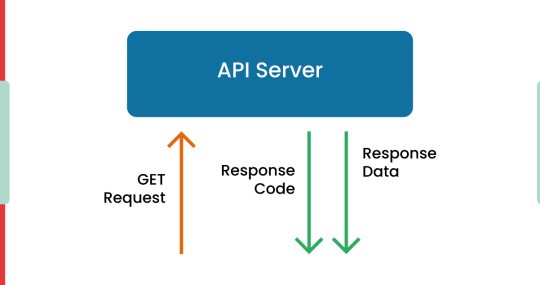
Use your preferred programming language or API client to send the HTTP request to the Zomato API endpoint.
Handle the API Response
Receive the JSON response from the API.
Parse the JSON data to extract the restaurant information you require. The data structure may vary based on the specific API endpoint.
Display or Use the Data
Utilize the obtained data according to your application's needs. You can display restaurant details, ratings, reviews, menus, and more.
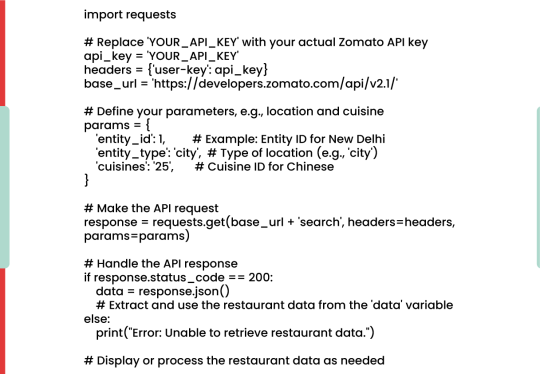
Please note that Zomato's API offers various endpoints for different purposes, so you can tailor your requests to obtain specific types of restaurant data. Make sure to read Zomato's API documentation for comprehensive details on available endpoints, parameters, and data formats.
The Different Types of Zomato APIs: A Comprehensive Overview
Zomato, a leading name in the world of restaurant discovery and food-related services, offers a range of APIs (Application Programming Interfaces) that cater to the diverse needs of developers, businesses, and food enthusiasts. These APIs provide access to a wealth of restaurant-related data, allowing developers to create innovative applications and solutions. In this detailed exploration, we'll delve into the various types of Zomato APIs and their specific use cases.
1. Zomato Search API
The Zomato Search API is a fundamental tool for discovering restaurants based on specific parameters. Developers can search for restaurants using various filters such as location, cuisine, establishment type, and user reviews. It's the go-to choice for applications that need to provide users with a curated list of dining options.
2. Zomato Restaurant API
The Restaurant API, as the name suggests, provides detailed information about a specific restaurant. Developers can access comprehensive data, including the restaurant's name, location, operational hours, user reviews, photos, and more. This API is ideal for applications that require in-depth knowledge about individual dining establishments.
3. Zomato Cuisine API
The Cuisine API focuses on one of the key aspects of dining - the type of cuisine. It allows developers to explore a wide range of cuisines and their availability in a given location. This API is beneficial for applications that want to offer users the opportunity to explore specific culinary experiences.
4. Zomato Category API
Categories play a crucial role in restaurant classification. The Category API provides information about different types of restaurants, helping users find the dining experience they desire. This API is essential for applications that aim to categorize and filter restaurants effectively.
5. Zomato Collection API
Collections often reflect popular themes or dining trends in a particular location. The Collection API enables developers to access curated lists of restaurants that fall under specific themes or categories. Applications that aim to showcase trending or unique dining experiences can benefit from this API.
6. Zomato Reviews API
User reviews are a significant part of the dining decision-making process. The Reviews API offers access to user-generated reviews, ratings, and comments about restaurants. This API is essential for applications that want to include authentic user feedback.
7. Zomato Location API
The Location API assists in retrieving information about different locations. Developers can access details such as the names of cities, localities, and establishment types. This API is beneficial for applications that require location-based services and recommendations.
8. Zomato Geocode API
Geocoding is crucial for accurately locating restaurants. The Geocode API converts an address into geographical coordinates (latitude and longitude), helping applications pinpoint the exact restaurant locations. This API is indispensable for mapping and navigation applications.
9. Zomato Delivery API
With the rise of food delivery services, the Delivery API has become vital. It offers information about food delivery options, minimum order amounts, and delivery times. Applications that focus on food delivery can use this API to provide valuable delivery-related details.
10. Zomato Dailies API
Dailies, or daily deals, are a popular aspect of dining out. The Dailies API provides information about daily specials, offers, and promotions at restaurants. Applications looking to showcase daily deals and discounts can integrate this API to provide real-time information to users.
11. Zomato User API
User profiles play a significant role in platforms that encourage user interactions. The User API enables developers to access user-specific data, including user profiles and activity. This API is essential for applications that aim to create a sense of community and engagement.
12. Zomato Collections API
Collections, as curated lists of restaurants, are a popular feature on the Zomato platform. The Collections API allows developers to retrieve information about these lists, making it possible for applications to feature curated dining options.
13. Zomato Table Booking API
Table reservations are a significant part of the restaurant experience. The Table Booking API allows developers to offer table reservation services to users, enhancing their dining experience through seamless reservations
14. Zomato Restaurant Widget API
The Restaurant Widget API provides developers with a widget that can be embedded into their websites. It allows for the integration of restaurant listings, reviews, and ratings, offering valuable content to users.
15. Zomato Gold API
Zomato Gold is a premium membership program offering discounts and benefits at partner restaurants. The Zomato Gold API provides access to information about Gold partner restaurants and their offers. It's essential for applications looking to incorporate Zomato Gold benefits into their services.
16. Zomato Pro API
Zomato Pro is another membership program that offers complimentary food delivery and dining experiences. The Zomato Pro API provides data related to partner restaurants and Pro-exclusive offers. Applications can use this API to enhance user experiences with Pro benefits.
17. Zomato Geospatial Search API
The Geospatial Search API combines location and cuisine searches, enabling developers to find restaurants within a specific area that offer particular cuisines. It's useful for applications focused on localized dining recommendations.
18. Zomato Lite API
Zomato Lite is designed for applications with limited resources or bandwidth. This lightweight version of the API offers essential functionality for restaurant discovery and access to basic data fields.
19. Zomato Developers API
The Developers API is the entry point for developers looking to explore and experiment with Zomato's API offerings. It provides access to basic data and functionality for development and testing.
Each of these Zomato APIs offers unique capabilities and data access, allowing developers to create a wide range of applications and services tailored to the needs of users, restaurateurs, and food enthusiasts. The choice of API depends on the specific requirements of your project, whether it's restaurant discovery, menu exploration, user engagement, or more. By leveraging the diverse capabilities of Zomato's APIs, developers can craft innovative solutions that enhance the dining experience and empower businesses in the culinary industry.
Conclusion
In this detailed guide, we've navigated the intricate world of the Zomato API and how to effectively harness it for scraping restaurant data. From searching for your favorite dining spots to obtaining in-depth restaurant details, Zomato's APIs empower developers and businesses to elevate the dining experience for users.
By understanding the various types of Zomato APIs, you can craft applications and services that cater to the diverse needs of food enthusiasts, restaurateurs, and culinary explorers. Whether you're building a restaurant discovery app, a food delivery platform, or a user engagement tool, Zomato's APIs provide the essential ingredients to create exceptional dining experiences.
Ready to embark on your culinary data journey? Start exploring the world of restaurants, menus, reviews, and more with the Zomato API, and unlock the potential for innovative and data-driven dining solutions. Begin your Zomato API journey today and savor the possibilities!
Know More:
https://www.realdataapi.com/scrape-restaurant-data-using-zomato-api.php
#Zomato API to Scrape#Zomato Restaurant API#Scraping restaurant data#Zomato Collections API#Extract Zomato Data API
0 notes
Text
Restaurant software is the best restaurant management system with a website and mobile application. You need a business plan and restaurant management system to accelerate your restaurant business. We have created a cost-effective software for you so that your restaurant billing software or restaurant POS software work together.
#restaurant marketing#restaurant point of sale#restaurant pos system#restaurant management software#restaurant design#restaurant data scraping#restaurant management system#restaurant menu scraper#restaurant moodboard#restaurant software#restaurant style#restaurant sales#restaurant seo#restaurant services#restaurant
1 note
·
View note
Text
How to Do Restaurant Data Collection Using Food Intelligence?
At Actowiz Solutions, were your window into the bustling US and UK restaurant industry. Dive into Actowiz Solutions Blog and Harness the Power of Real-Time Data.
0 notes
Text
Food Delivery App Scraping Services | Extract Restaurant Menu Data
Elevate your food business with our Food Delivery App Scraping Services. We can extract restaurant menu data from the USA, UK, UAE, Canada, China, India, and Spain.
know more: https://www.mobileappscraping.com/food-delivery-app-scraping-services.php
#Food Delivery App Scraping Services#extracting data from food delivery app#Food Delivery Mobile App Data Scraping#Extract Restaurant Menu Data
0 notes
Text
Get Your Hands on Ubereats Data: A Beginner's Guide to Web Scraping
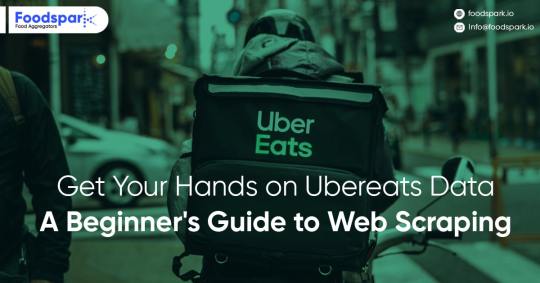
Are you looking to scrape data from the Ubereats food delivery website? In this comprehensive guide, we'll walk you through the process of web scraping, from selecting the right tools to extracting data and storing it in a usable format. Whether you're an analyst or a data enthusiast, this guide will help you get started with web scraping and explore the wealth of data available on Ubereats.
#food data scraping services#grocerydatascraping#restaurant data scraping#zomato api#competitor's brand monitoring#fresh direct grocery data scraping#food data scraping#grocerydatascrapingapi#restaurantdataextraction#fooddatascrapingservices
2 notes
·
View notes
Text
Unveiling the Gastronomic Universe: Harnessing the Power of Restaurant Menu and Location Data Scraping

In the digital age, data is the new currency, and in the culinary world, restaurant menus and locations are treasure troves of information waiting to be explored. With the rise of food delivery apps, online reviews, and culinary tourism, the demand for comprehensive restaurant data has never been higher. Fortunately, the solution lies in the art of web scraping – a technique that allows us to extract valuable data from websites efficiently. In this blog post, we delve into the world of restaurant menu and location data scraping, exploring its benefits, challenges, and applications.
Understanding Restaurant Data Scraping
Restaurant data scraping involves extracting structured data from restaurant websites, including menus, locations, contact information, and more. This process typically utilizes web scraping tools and techniques to navigate through web pages, locate relevant data, and extract it in a usable format.
Unveiling the Menu: Extracting Culinary Delights
One of the primary objectives of restaurant data scraping is to extract menu information. Menus are not just lists of dishes; they represent a culinary narrative, showcasing a restaurant's identity, specialties, and culinary creativity. By scraping menu data from restaurant websites, businesses can gain insights into popular dishes, pricing strategies, ingredient trends, and menu innovations.
Pinpointing Locations: Mapping Culinary Landscapes
Location data scraping focuses on extracting information about a restaurant's physical location, including addresses, contact details, opening hours, and geographical coordinates. This data is invaluable for mapping culinary landscapes, identifying food trends across different neighborhoods, and optimizing delivery routes for food delivery services.
The Benefits of Restaurant Data Scraping
Market Research: By analyzing menu data from various restaurants, businesses can identify emerging culinary trends, consumer preferences, and competitive landscapes. This information is invaluable for market research and strategic decision-making.
Personalized Recommendations: Restaurant data scraping enables personalized recommendations for users based on their culinary preferences, dietary restrictions, and location. This enhances the user experience and increases customer satisfaction.
Operational Efficiency: For food delivery services and restaurant aggregators, location data scraping streamlines operations by providing accurate information about restaurant locations, opening hours, and delivery zones. This optimizes delivery logistics and enhances service reliability.
Competitive Intelligence: By monitoring competitor menus and pricing strategies, businesses can gain valuable insights into market dynamics, identify gaps in their offerings, and refine their marketing strategies to stay ahead of the competition.
Challenges and Considerations
While restaurant data scraping offers numerous benefits, it also presents several challenges and considerations:
Website Structure: Restaurant websites vary in structure and design, making it challenging to develop universal scraping algorithms. Customized scraping scripts may be required for each website, increasing development time and complexity.
Data Accuracy: Ensuring the accuracy and reliability of scraped data is crucial, as inaccuracies can lead to misleading insights and operational inefficiencies. Regular data validation and verification processes are essential to maintain data quality.
Ethical and Legal Considerations: Scraping data from websites without permission may raise ethical and legal concerns, particularly regarding copyright infringement and data privacy. Businesses must ensure compliance with relevant regulations and obtain consent where necessary.
Conclusion
In the era of big data, restaurant data scraping emerges as a powerful tool for unlocking valuable insights from the culinary world. By harnessing the power of menu and location data scraping, businesses can gain a competitive edge, enhance customer experiences, and navigate the ever-evolving landscape of the food industry. However, it is essential to approach data scraping ethically, respecting website terms of service and privacy policies, to ensure a sustainable and responsible data ecosystem. As technology continues to evolve, the possibilities for restaurant data scraping are limitless, promising to revolutionize the way we explore, experience, and appreciate the culinary universe.
0 notes
Text
0 notes
Text
A Guide to Scraping Restaurant Data from Deliveroo, Talabat, and Careem
Unlock the power of data with our comprehensive guide on scraping restaurant data from three of the most prominent food delivery platforms: Deliveroo, Talabat, and Careem.
know more
https://medium.com/@actowiz/a-guide-to-scraping-restaurant-data-from-deliveroo-talabat-and-careem-982cec8a2c39
0 notes
Text
How to Use Zomato API to Scrape Restaurant Data – A Detailed Guide
Discover the power of Zomato API for restaurant data scraping. Dive into our detailed guide and unlock valuable insights.
Know More:
https://www.realdataapi.com/scrape-restaurant-data-using-zomato-api.php
#Zomato API to Scrape#Zomato Restaurant API#Scraping restaurant data#Zomato Collections API#Extract Zomato Data API
0 notes